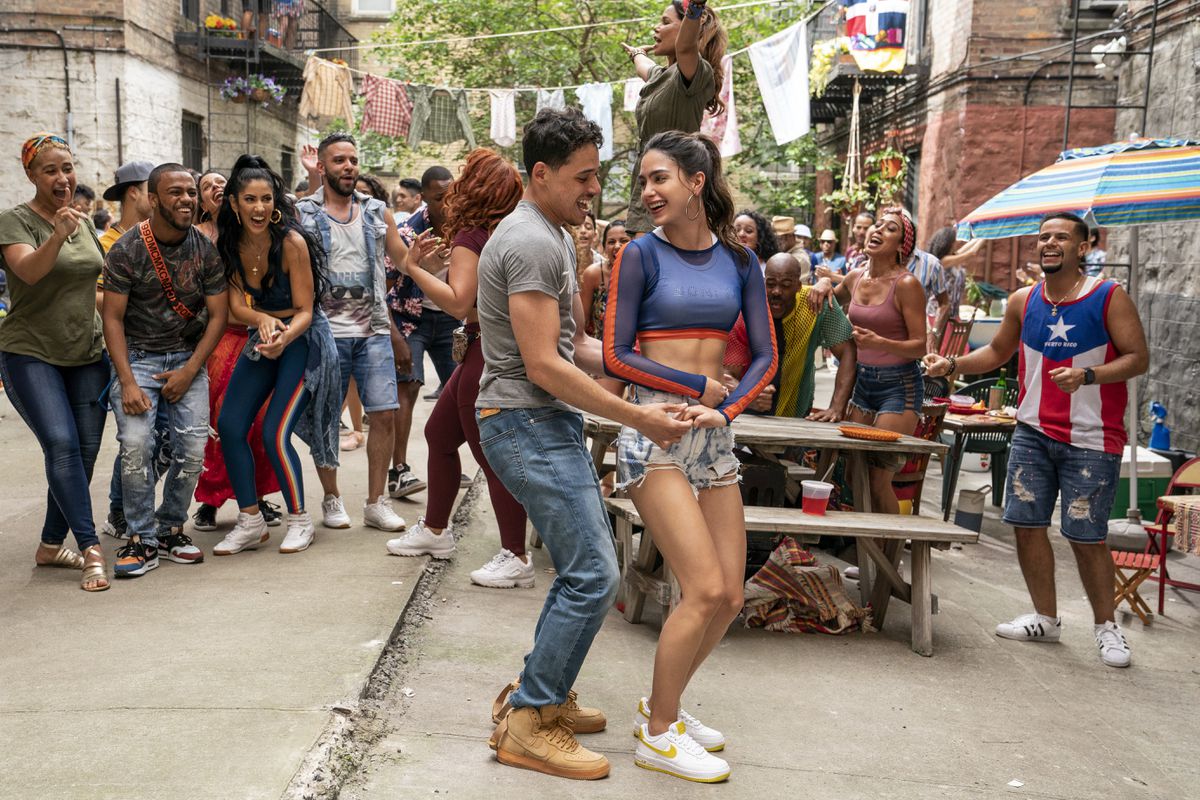With the afterglow of Hamilton’s success lasting seemingly forever, Warner Bros. is riding the Lin-Manuel Miranda train back into the past with In the Heights, an adaptation of Miranda’s first Broadway musical. The team behind the adaptation is formidable: playwright Quiara Alegría Hudes, author of the script for the stage play, returns to write the screen version, and director Jon M. Chu—fresh off his acclaimed work on Crazy Rich Asians—is helming a music-centric movie for his sixth time. With minds like that and a budget of $55 million, Warner Bros. must be hoping for a Hamilton-sized splash.
They even cast Hamilton star Anthony Ramos as lead character Usnavi de la Vega. Usnavi runs a bodega in Washington Heights, but his dream is to return to the Dominican Republic and restore his father’s old restaurant. In the meantime, he saves his money, looks after his little cousin Sonny, and thirsts after neighborhood girl Vanessa, a salon worker who dreams of moving downtown and pursuing fashion. Other friendly faces include Nina, who “made it out” to Stanford but recently dropped out; Benny, an entrepreneurial friend of Usnavi and more-than-friend of Nina; and Claudia, the barrio’s honorary abuela, who just wants to see her community—and herself—happy.
READ ALSO: Here’s who made the ‘Celebs Gone Good’ list
She doesn’t have to look far. In the Heights is smiles from the first note, kicking off with an upbeat number about the neighborhood and its tight-knit residents. Lin-Manuel Miranda’s songwriting style is noticeable from the get-go: lyrical exposition, tons of syllables packed into each verse, and a hip-hop flavor that samples from the cultures on display. Its energy is alluring. And Anthony Ramos immediately makes a case for movie stardom—he’s got pipes, moves, and a knack for physical comedy that puts him in league with the likes of Taye Diggs. It’s only the first course and In the Heights already has all the right ingredients.
And director Jon M. Chu has the spice. A musical is a fun space for a director to work in—you can go way bigger than reality, what with the heightened atmosphere and the bursting into song. Chu seizes that opportunity and peppers the film with fun, interesting touches ranging from unintrusive special effects to impressive cinematic sleights of hand. It’s a visual spectacle in ways large and small. It’s beautifully organized, too. A musical is chaos that must be choreographed and controlled. No one wants to watch a musical that looks like a Michael Bay film because the director and editor couldn’t get a handle on all the moving parts. But Chu, cinematographer Alice Brooks, and editor Myron Kerstein do a remarkable job presenting the big, bursting showiness of In the Heights in crystal clarity. The experience and synergy are tangible: Chu got his start with the dancey Step Up series, Brooks shot Chu’s musical Jem and the Holograms, and Kerstein edited Chu’s Crazy Rich Asians. During the movie’s most spectacular sequences—the song “96,000”, featuring a dance number in a public pool, is a major standout—you get the sense that a singular vision was synchronized across a troupe of talented brains. The number of factors working in tandem, from concept to execution, is a sight to behold.
Not every sequence is so inspired. Chu doesn’t have as creative a grasp on the slower songs, but to be fair, neither does Lin-Manuel. In the absence of a lively beat, the mournful, lower-key stuff sounds like stock melodies—one lyrical lament comes off like a perfunctory “On My Own”, as it were. Later in the film, though, it’s difficult to discern if the slower moments aren’t working due to the songs themselves, or if they’re casualties of In the Heights’ crucial weakness: its screenplay.
A lot goes on in the movie’s two-and-a-half hours. So much, in fact, that the creative team cut seven numbers from the original show to make it all fit—and five of the missing numbers are from the second act, which has been cut down to skin and bones. The gamble of tightening things up for the screen doesn’t pay off. While In the Heights’ individual moments can be dazzling, the film is less than the sum of its parts: its narrative too often feels like a best hits collection of the stage musical. The main ensemble is so large that no one really gets their due—a few lines about their dreams and struggles before the movie whips to the next character. When their problems reach a climax and the dramas come to a head, the scarcity of character-building does too. Fallouts between characters happen in implausible instants, and the worst tragedy of all—the one that’s meant to change everyone for the better in the end—is dwelled on for three, maybe four minutes? If it weren’t for a talented cast and the candid empathy with which the movie approaches diasporic cultures, In the Heights’ story wouldn’t have two legs to stand on.
Which, oddly, makes the movie more impressive when it does work. It still dances despite its leglessness. Even if the story is too scattershot to simmer in your mind once it’s over, the unbridled joy of its high points is effervescent in the moment.
★★★ (3/5)




